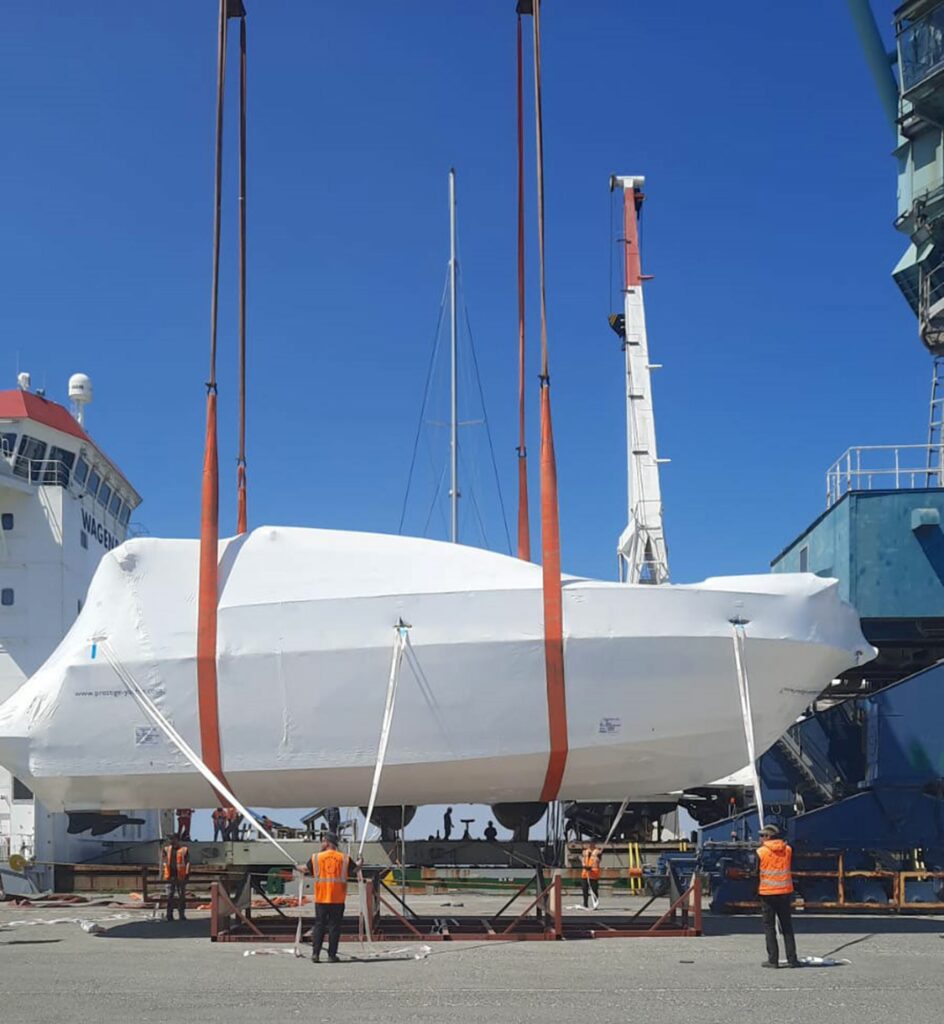Like with everything, there are of course hazards when it comes to shipping your yacht on an ocean-going vessel. This is something that we are aware of having been in the yacht shipping business for over 25 years. One such hazard is that of the appearance of rust spots, or soot marks, noticed on the gel covering of some yachts after shipment.
What causes Rust Spots?
Rust Spots appear to be more prevalent on (but not limited to) either (i) older yachts where the gel coat is less polished and hence more porous, or (ii) brand new yachts where the gelcoat has perhaps not fully cured. Some very extreme examples of rust spotting can be seen in the above photos.
After extensive research involving our insurers and some industry experts, we believe rust spotting is mainly caused by cinders/soot escaping from the ships funnel. When the wind is in the wrong direction these can land on the yachts in some circumstances causing rust spots. We say “in some circumstances” because we have had situations where only one yacht on a ship is affected despite others being within close proximity. This is likely due to specific gel coatings used on yachts. Other causes can be from metal filings or rust particles being whipped up into the air.
Limiting Damage
Unfortunately, damage like this is one of the risks of shipping a yacht. Similar to that of Seagulls defecating all over your yacht we can’t control the wind, nor the extent or direction of the exhaust’s fumes coming from the funnel.
To limit damage to yachts being transported, we are continuously striving to take on vessels of the highest standards, with our own insurance policy refraining us from taking on vessels over a certain age.
To mitigate the risk of this happening, Peters and May can offer that the crew of the cargo vessel washes your yacht with fresh water during the shipment.
Please discuss the frequency and costs with your Peters & May account manager. This service is subject to the crew’s availability as their time may be limited during the sea-voyage due to other urgent tasks they may have to fulfil and subject to weather.
Any costs that are occured for this service are to be paid in cash to the crew or captain of the vessel on collection of your yacht at the port of discharge. For further information, please speak to your account manager.

Alternative options that we believe an owner can do to protect their yacht against any contamination or damage during shipment.
Option 1: Protective Coatings
A costly, but long-term solution to the protection of your yacht against contaminants is the application of a protective coating to prevent contamination.
Although this is certainly not a necessity, this is an option for customers looking to guarantee full protection of their yacht during shipment and beyond. Links to the following websites may point yacht owners in the right direction to arrange such protective solutions:
https://www.protectapeel.co.uk/
Option 2: Partial Shrink Wrapping
Another option to protect your yacht is partial wrapping, covering areas prone to exposure during shipment such as decking and chrome fittings. A cheaper solution, partial wrapping can take place before loading of a yacht to provide protection against contaminants and weather elements in all susceptible areas.
Option 3: Full Shrink Wrapping
For customers interested in full coverage of their yacht during transit, full shrink wrapping is a possible solution. It is however worth nothing that although full wrapping provides protection against fair weather elements and general dirt; it does come with disadvantages, specifically causing potential complication with the loading and lashing of your yacht.
Disadvantages of shrink wrapping
- If cleats and bollards are not exposed holes will need to be cut in the cover to allow yachts to be lashed.
- Covering must be done on board the vessel which is subject to stow determining if it is possible.
- In some cases, covers can’t be fitted due to high wind or heavy rain weather conditions.
- Health and safety procedures can limit the ability to fit covers as a result of restrictions for working at height and hot works permit requirements.
- Due to tight timeframes and loading schedules sometimes there is simply not time to fit covers – unfortunately, a ship will not wait without being paid to do so!
- Some covers can become torn or detached during transit, eventually causing damage from flapping / chaffing.
- Shrink wrapping can conceal lifting points or fragile components.
- Water can collect on areas of a cover with increased weight, this can cause damage to handrails or other protrusions.
- In humid conditions a cover can increase the level of condensation inside the yacht which can lead to mould contamination.
- Plastic covers do not provide guaranteed protect against hot cinders.
- Full shrink wraps can prevent access onboard if required (e.g. customs).
- Shrink wrapping can conceal lifting points or fragile components.
Although damage and contamination during shipment is rare, if protection is something you are interested in and would like to discuss with the team, please get in contact with your local office.
